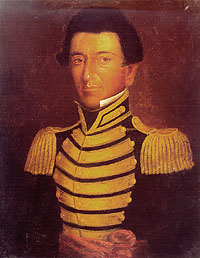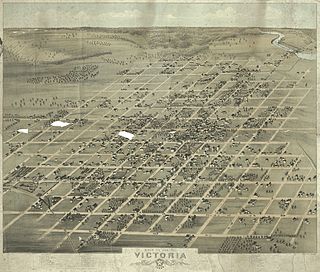Related Research Articles

The Texas Revolution was a rebellion of colonists from the United States and Tejanos against the centralist government of Mexico in the Mexican state of Coahuila y Tejas. Although the uprising was part of a larger one, the Mexican Federalist War, that included other provinces opposed to the regime of President Antonio López de Santa Anna, the Mexican government believed the United States had instigated the Texas insurrection with the goal of annexation. The Mexican Congress passed the Tornel Decree, declaring that any foreigners fighting against Mexican troops "will be deemed pirates and dealt with as such, being citizens of no nation presently at war with the Republic and fighting under no recognized flag". Only the province of Texas succeeded in breaking with Mexico, establishing the Republic of Texas. It was eventually annexed by the United States.

Victoria County is a county located in the U.S. state of Texas. As of the 2020 census, its population was 91,319. Its county seat is also named Victoria. Victoria County is included in the Victoria, TX Metropolitan Statistical Area, and comprises the entirety of the Victoria, TX media market.

The Battle of San Jacinto, fought on April 21, 1836, in present-day La Porte and Deer Park, Texas, was the final and decisive battle of the Texas Revolution. Led by General Samuel Houston, the Texan Army engaged and defeated General Antonio López de Santa Anna's Mexican army in a fight that lasted just 18 minutes. A detailed, first-hand account of the battle was written by General Houston from the headquarters of the Texan Army in San Jacinto on April 25, 1836. Numerous secondary analyses and interpretations have followed.

The Goliad massacre was an event of the Texas Revolution that occurred on March 27, 1836, following the Battle of Refugio and the Battle of Coleto; 425–445 prisoners of war from the Texian Army of the Republic of Texas were executed by the Mexican Army in the town of Goliad, Texas. The men surrendered under the belief they would be set free within a few weeks; however, this was not to be. Despite appeals for clemency by General José de Urrea, the massacre was carried out by Lt. Colonel José Nicolás de la Portilla, under orders from General and President of Mexico, Antonio Lopez de Santa Anna.

James Walker Fannin Jr. was an American military officer, planter and slave trader who served in the Texian Army during the Texas Revolution. After being outnumbered and surrendering to the Mexican Army at the Battle of Coleto Creek, Fannin and his fellow prisoners of war were massacred soon afterward at Goliad, Texas, under Antonio López de Santa Anna's orders. He was memorialized in several place names, including a military training camp and a major city street in Houston.

Juan Nepomuceno Seguín was a Spanish-Tejano political and military figure of the Texas Revolution who helped to establish the independence of Texas. Numerous places and institutions are named in his honor, including the county seat of Seguin in Guadalupe County, the Juan N. Seguin Memorial Interchange in Houston, Juan Seguin Monument in Seguin, World War II Liberty Ship SS Juan N. Seguin, Seguin High School in Arlington.
The battle of Agua Dulce Creek was a skirmish during the Texas Revolution between Mexican troops and rebellious colonists of the Mexican province of Texas, known as Texians. As part of the Goliad Campaign to retake the Texas Gulf Coast, Mexican troops ambushed a group of Texians on March 2, 1836. The skirmish began approximately 26 miles (42 km) south of San Patricio, in territory belonging to the Mexican state of Tamaulipas.

The Presidio Nuestra Señora de Loreto de la Bahía, known more commonly as Presidio La Bahía, or simply La Bahía, is a fort constructed by the Spanish Army. It became the center of a community that developed as the modern-day city of Goliad, Texas, United States. The current location dates to 1747.
The DeWitt Colony was a settlement in Mexico founded by Green DeWitt. From lands belonging to that colony, the present Texas counties of DeWitt, Guadalupe and Lavaca were created. The hub of the colony was primarily located, however, in what is now Gonzales County. The first battle of the Texas Revolution occurred in the DeWitt Colony.

Green DeWitt was an empresario in Mexican Texas. He brought families from the United States to what is now South-central Texas and founded the DeWitt Colony.
Rafael Antonio Manchola was a politician and military officer in Mexican Texas. He twice served as commandant of Presidio La Bahía. He served two terms in the legislature of the state of Coahuila y Tejas. At his behest, the community which had grown outside the fort was renamed Goliad and elevated in status to a villa. During his legislative service, Manchola also negotiated official boundaries for the colony of his father-in-law, Martín De León, and had a commissioner appointed to grant official titles to the settlers in that colony. After returning home, Manchola became the alcade of Goliad and initiated a resolution–then considered illegal– supporting the Constitution of 1824 and Mexican President Antonio Lopez de Santa Anna. He briefly attended the Convention of 1832 and volunteered to accompany William H. Wharton in journeying to Mexico City to request separate statehood for Texas. The mission was postponed, and Manchola died of cholera in late 1832 or early 1833.
Salvador Flores served as a volunteer in the Texan Army in 1835–1836. He was instrumental in organizing and commanding Texian volunteers in support of the Texas Revolution. He participated in many battles and would rise through the ranks to reach Captain status during the fight for Texas independence from Mexico. Salvador continued to provide protection for the ranches and settlers of Texas throughout the Republic years.

José María Jesús Carbajal (1809–1874) was a Mexican Tejano who opposed the Centralist government installed by Antonio López de Santa Anna, but was a conscientious objector who refused to take up arms against his own people. Mexican conscientious objectors paid a price for their refusals, in that Texan Brigadier General Thomas Jefferson Rusk confiscated the homes of those who wished to remain neutral in the war. In July 1836, Rusk ordered the Carbajal and other Tejano families of Victoria escorted off their own land. They took refuge in New Orleans.
Plácido Benavides (1810–1837) was an early Mexican-born settler in De Leon's Colony, Victoria County, Texas. Benavides earned himself the sobriquet of the Paul Revere of Texas for his 1836 journey from San Patricio to Goliad to Victoria, warning residents of the approaching Mexican army. He was twice elected alcalde of Victoria, Texas. He married into the powerful De León family, and with his wife Agustina became the father of three daughters. Benavides fought against the dictatorship of Antonio López de Santa Anna, but did not feel Texas should be separated from Mexico.
Silvestre De León (1802–1842) was the second son born to the influential De León family in Victoria, Texas. He became the third alcalde of Victoria. De León joined his brother-in-law Plácido Benavides to fight with Stephen F. Austin at the 1835 Siege of Béxar. He joined the rest of the De León family in New Orleans in 1836 after Brigadier General Thomas Jefferson Rusk ordered the evacuation of Mexican families from Victoria. In 1842, he returned to Victoria and was murdered by persons unknown. Texas Historical Marker number 6544 placed at Evergreen Cemetery in 1972 acknowledges Silvestre De León's contribution to Texas.

De León's Colony was established in 1824 in the northern Coahuila y Tejas state of the First Mexican Republic, by empresario Martín De León. It was the only ethnically Mexican colony founded during the Mexican period (1824-1835) that is located within the present-day U.S. state of Texas.

Martín De León (1765–1833) was a rancher and wealthy Mexican empresario in Texas who was descended from Spanish aristocracy. He was the patriarch of one of the prominent founding families of early Texas. De León and his wife Patricia de la Garza established De León's Colony, the only predominantly Mexican colony in Texas. They founded the town of Villa de Nuestra Señora de Guadalupe Victoria Nombre de Jesús on the Guadalupe River. The name referred both to the river and to Mexico's president Guadalupe Victoria.
Patricia de la Garza De León (1775–1849) was the matriarch of one of the prominent founding families of early Texas. Doña Patricia raised ten children, some of whom helped change the course of history. At age 49, she uprooted her life in 1824 to help her husband Martín De León establish the predominantly Mexican De León's Colony. She contributed her inherited assets to the founding of the colony, and helped establish a school and a church. From the onset, she worked to instill a sense of Mexican and Spanish culture in the colony. After the death of her husband, Doña Patricia assumed the role of head of the family. Recorded Texas Historic Landmark number 6539 placed at Evergreen Cemetery in 1972 acknowledges Patricia de la Garza De León's contribution to Texas. Recorded Texas Historic Landmark number 6543 placed at Church and Bridge Streets in 1936 denotes the home of Patricia de la Garza De León and Don Martin De León's home in Victoria.
Paul Revere of Texas is a sobriquet given to people during the Texas Revolution for alerting settlers about Mexican troop movements. It is a reference to Paul Revere because of the similar circumstances in 1775 when Revere and William Dawes responded to information from Joseph Warren about movement of British forces. The duo made rides alerting Samuel Adams, John Hancock and colonial militia troops.
Captain Carlos de la Garza (1807–1882), also known as "Don Carlos," was a fourth generation Tejano rancher and entrepreneur in Goliad, Victoria and Refugio counties of Texas. His participation in the Mexican Army leading to the Battle of Coleto was instrumental in the surrender and demise of Colonel James Fannin and the Texian forces.
References
- Chance, Joseph E (2006). Jose Maria de Jesus Carvajal: The Life and Times of a Mexican Revolutionary. Trinity University Press. ISBN 978-1-59534-020-7.
- Hardin, Stephen L (2010). "Plácido Benavides: Fighting Tejano Federalist". In De la Teja, Jesús F. (ed.). Tejano Leadership in Mexican and Revolutionary Texas . Texas A&M University Press. ISBN 978-1-60344-302-9 – via Project MUSE.